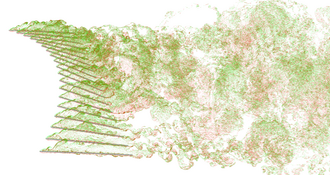Prediction of aeroelastic response of bridge decks using artificial neural networks
Link: https://doi.org/10.1016/j.compstruc.2020.106198
A methodological framework is developed for robust and efficient prediction strategies for complex aerodynamic phenomena using hybrid models that employ numerical analyses as well as meta-models. Here, an approach to predict motion-induced aerodynamic forces is developed using an artificial neural network (ANN). The input to the ANN is the response time histories of a bridge section, whereas the output is the motion-induced forces. The proposed methodology has wide application in the analysis and design of long-span bridges.
An extension of pseudo-3D vortex particle methods for aeroelastic interactions
Link: https://doi.org/10.1016/j.jweia.2020.104391
Accurate prediction of interaction between fluid flow and moving deformed body is a challenging multi-physics problem. A new extension of vortex particle methods (VPM) is developed, which is in the context of a pseudo-three-dimensional (pseudo-3D) multi-slice coupled model for complex fluid-structure interaction of thin-walled structures. The coupled model allows analysing aeroelastic interactions of thin- flexible shell systems such as membrane roofs and chimneys.
Comparison Metrics for Time-Histories: Application to Bridge Aerodynamics
Link: https://doi.org/10.1061/(ASCE)EM.1943-7889.0001811
A significant number of aerodynamic force models are used to assess the performance of bridges that indicates an important question regarding their comparison and validation. This study utilizes a unified set of metrics for a quantitative comparison of time-histories in bridge aerodynamics with a host of characteristics. The outcome of the study is intended to provide a framework for quantitative comparison and validation of aerodynamic models based on the underlying physics of fluid-structure interaction.
Single and multi-objective shape optimization of streamlined bridge decks
Link:https://doi.org/10.1007/s00158-019-02431-3
Shape optimization of tall buildings and bridge cross-sections is still an open and inspiring research field. The paper presents a framework for single and multi-objective shape optimization of static aerodynamic forces for a streamlined box section. Computational fluid dynamic simulation based on the vortex particle method provides the quantities of interest approximately treated by a Kriging surrogate for the optimization.








